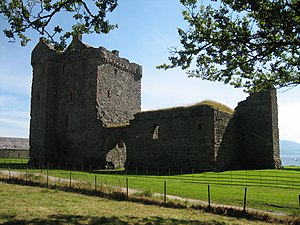Skipness Castle
| Skipness Castle | |
|---|---|
|
The ruins of Skipness Castle |
|
| Creation time : | early 13th century |
| Castle type : | Niederungsburg |
| Conservation status: | ruin |
| Place: | Skipness |
| Geographical location | 55 ° 46 '5 " N , 5 ° 20' 11" W |
Skipness Castle is a ruined castle near the Scottish village of Skipness not far from the ferry terminal at Claonaig on the east side of the Kintyre peninsula .
The oldest structures of the castle complex date from the early 13th century and consist of a large stone building with a rectangular base. This contained a large hall and cellar rooms on the ground floor, as well as some chambers above. To the southeast of it stood a chapel, of which only the south wall has survived. This was later integrated into the castle wall.
The construction is probably due to the clan lord MacSween , who in 1261 built the nearby “St. Columba Chapel “to the monks of Paisley Abbey, or to his son Dugald. A year later, Skipness Castle was owned by King Alexander III. to Walter Bailloch Stewart, 4th Earl of Menteith . Around 1300 the castle was further fortified and expanded into the complex, the remains of which can still be seen today. The responsible builder is unknown.
Apart from the more modern elements that were added to the building in later years, Skipness Castle represents a type of construction that is typical of western Scotland and is also known as the castle of enceinte . With this type of construction, the defense capability is concentrated in a single massive castle wall - in this case supplemented by towers.
The importance of Skipness Castle probably declined with the construction of the castle in Tarbert , which was given into the hands of the MacDonald clan by King Robert the Bruce in 1325 . In the period that followed, the castle complex changed hands several times. During the 16th century, Skipness Castle underwent further remodeling when a new tower house was built on top of the earlier structures in the northeast corner. During the 17th century, Skipness Castle was abandoned and abandoned. The surrounding buildings were torn down in the 18th century when the courtyard was converted into a farm . Its buildings were destroyed in 1898.
The ruins of Skipness Castle are under government protection. The aim is to preserve the historical building and cultural property through construction measures, which is now a popular destination for tourists .
Trivia
The spirit of the “Green Lady” is said to be at work in Skipness Castle. More like a fairy than a ghost, she is supposed to protect her home and the inhabitants living in it by confusing possible attackers in a supernatural way.
Individual evidence
- ↑ Green Lady on HollowHill.com
literature
- Geoffrey Stell: Dunstaffnage and the castles of Argyll . Historic Scotland, Edinburgh, 1994, reprinted 1996. ISBN 0-7480-0481-5 .
Web links
- Description and pictures (English)

